INDUSTRY 4.0 – NEW REVOLUTION
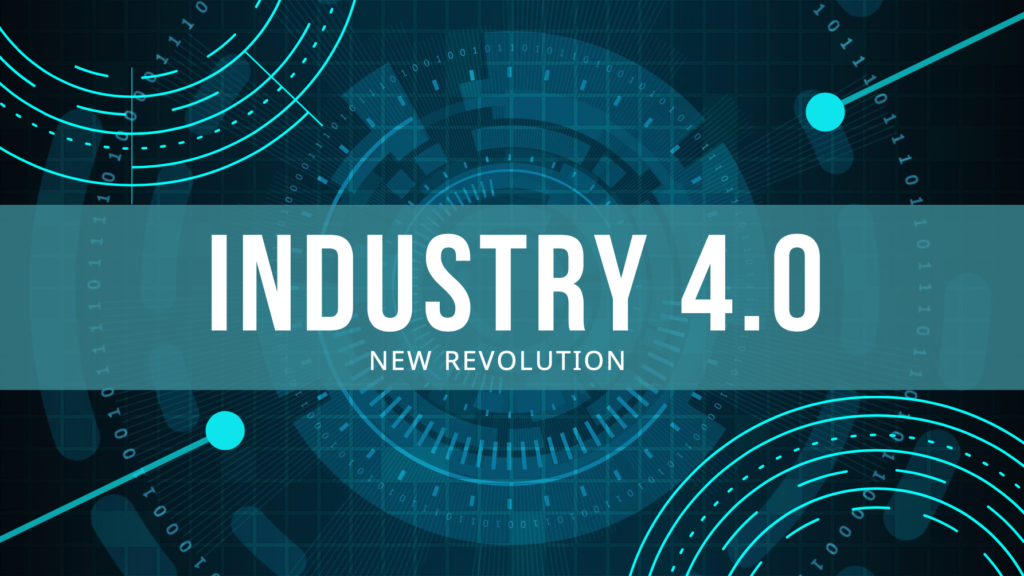
WHAT IS IT
In order to start developing the concept of Industry 4.0 it is important to understand the basics of it. Delving deeply into the meaning of the term itself, it could be denominated as the fourth industrial revolution, which is characterized by the transformation process of digitization, interconnection and intelligent networking. These procedures are carried out specifically in companies through the proposal of new ways of production, value creation automation and optimization, counting on the presence of information and communication technology agents (ICT).
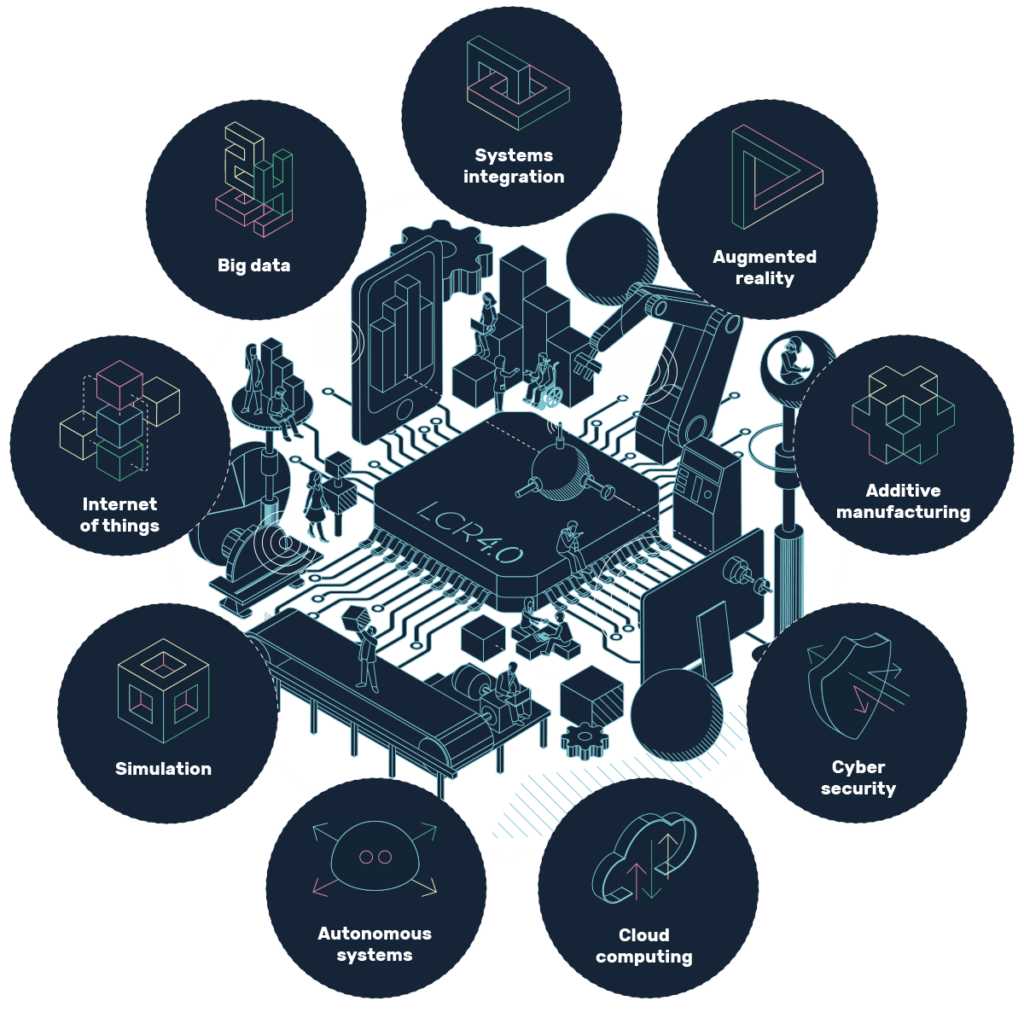
Nowadays the concept Industry 4.0 is considered a trending approach which is taken into account by several companies worldwide. The emergence of technologies such as Internet of things (IOT), cloud computing services, robotics, artificial intelligence (AI), nanotechnology, etc is part of what Industry 4.0 bases its performance. It is a sector that affects several manufacturing industries, which will be analyzed throughout the reading. However the main objective of this approach is to increase efficiency, reduce time costs and become customer centric regarding the business point of view.
FIGURE 1: TECHNOLOGICAL COMPONENTS OF INDUSTRY 4.0
The main revolutionary aspect from this concept is the fusion between advanced level production processes and intelligent technology agents in business models, which is a process that has never been seen before in the history of mankind. Nowadays one of the most important challenges faced by an organization’s decision making process, is to identify which technology to invest in, or which is their preferred process to modify in their corporate view, which will definitely be improved by the incorporation of industry 4.0. This procedure is carried out through the evaluation of what adapts best to their necessities rusbankinfo
Continuing with the business focus, it is important to outline the organizational change that this revolution is occasioning. There is a clear transformation on the way that businesses will carry out their activities from this point onwards. Nowadays thanks to digitalization, many processes are being modified, including the possibility to access content and carry out functions from different sources, which implies a continuous cycle, with constant activity 24/7.
HOW DID IT EMERGE
In order to analyze how this concept has emerged, it is important to be clear that it is one of the industrial revolutions that have appeared throughout history. To better understand its evolution it is necessary to put it in context with the rest of the industrial revolutions and understand how it differs from the previous ones.
Figure 2: DELOITTE REPORT about industrial evolution
The first industrial revolution was characterised by the mechanisation of production with the steam engine. The second was distinguished by mass production and the emergence of new ways of obtaining energy such as electricity. On the other hand, new information and communication technologies appeared in the third revolution, giving rise to new technological advances. This results in what we now know as the Fourth Industrial Revolution, which is unique from the previous ones because of its speed of evolution. Likewise, it is considered that it differs from the third due to the great automation, extreme computing and maximum connectivity.
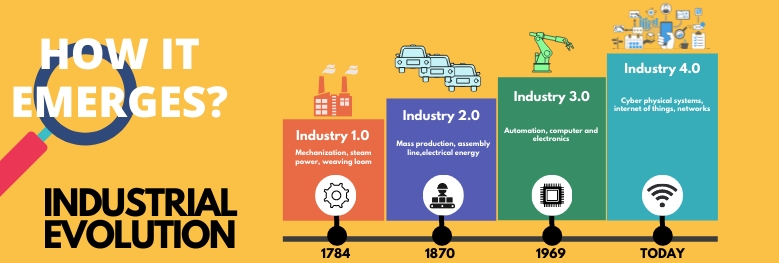
This term originated in Germany in 2011 and was later adopted by more countries. The Fourth Industrial Revolution may be considered to have gone through three waves. The first, which were part of the third revolution, are related to the emergence of integration systems and the Internet. And the third, which can be considered its precursor, was the emergence of the IoT and the strong development of the proliferation of mobile devices and their connectivity. Industry 4.0 is based on the cyber-physical production system and the emergence of virtual worlds. However, the main element of this new revolution that we are experiencing can be attributed to smart factories, which have a greater adaptation to production needs, as well as to improved resource efficiency.
“The Fourth Industry Revolution is still in its nascent state. But with the swift pace of change and disruption to business and society, the time to join in is now”
– Gary Coleman, Global Industry and Senior Client Advisor, Deloitte Consulting
INDUSTRY 4.0 ENVIRONMENT
For this new industry, the interconnection with other emerging smart sectors such as those for smart buildings, smart homes, smart grid or smart logistics is crucial. Interconnection in the context of Industry 4.0 refers to the capacity of technology and people to interact easily in a smart environment. In fact, its principal idea is to create a comprehensive and integrated ecosystem for all them. This is closely related to the Internet of Things concept.
FIGURE 4: THE INDUSTRY 4.0 ENVIRONMENT
In this way, the interface with business and social networks, the corporate web and the social web, are of great importance in the digital transformation towards industry 4. 0. And all these new links and networks that this revolution provides within an ‘internet of people, of data, of services and of things’ mean that the manufacturing and production methods are still about to experience massive transformations.
We can see that in some manufacturing companies and industrial sectors, this process is only getting started, but in others, the transition to Industry 4.0 is already well underway.
IMPACTS
Industry 4.0 has symbolized a new era revolutionizing many sectors but it has mainly impacted three core areas. First, on the ecosystems one. By this we refer to all the agents that are part of the business environment such as suppliers, third parties, shareholders, and regulations that may affect the business. The impact is mainly focused on the way all of these agents communicate and are linked with each other. Secondly, it has repercute towards the organizational area as Industry 4.0 is giving leverage to firms in a way they are able to track real time data information as well as predict trends and production needs in order to optimize their manufacturing. And, finally, it has impacted at the individual level. This new industry is bringing out disruptive changes that require specific abilities and attention in order to be understood and applied. This is why there is a need for new careers and formation that could satisfy and cover the gap of the new demand emerged by this industry.

We could also mention an important concept called “Industry 4.0 lighthouses”. These are companies that are distributed all over the world and have digitized all their entire supply chain from suppliers to manufacturing; including all upstream and downstream operations. They have different structural sizes comprising big, small and medium firms. The interesting point in all of this is that they all share a common point based on the fact that they have undertaken a “triple transformation” as explained in one McKinsey report. This transformation is composed of three pillars of change that impact at a business, technological and organizational levels. At business level, they all previously centered on determining the future´s company and linking it with their actual goals and strategy, also, at technological levels they desired to upgrade their current IT systems and operations. By this they could engage in partnerships with other firms creating an ecosystem of digital transformation that will impulse them with the most optimal initiatives. And finally at the organizational level, they all has four statements in mind: the need of a cross-functional team and governance; great commitment of the top-managers as they will propell new transformations; acquisitions of new digital capabilities and finally, the implementation of new ways of working such as agile methodologies based on the need of breaking into pieces the whole project in order to provide continuous improvements at all stages.
HOW TO MANAGE INTERNET PROJECTS
In relation to how to manage an internet project, both project managers and small business leaders have to be prepared for the entrance in a connected workplace. The technology of IoT is applied also in this field in orden to ensure actions such as team collaboration or data collection. This last is a breakthrough in this area as it allows leaders to be informed and consequently, to make better decisions for the business. For instance, in the supply chain department, inventory and resources will be easily and constantly monitored thanks to this technology.
On the other hand, the automatization could also be applied to different devices that could respond to external factors and respond to what is happening around them and their network. This will drastically reduce the intervention of humans, reducing operating costs and increasing the response time. In addition, the errors that may occur throughout the process will also be minimized and customer service will be better and faster.
FIGURE 7: EFFECT OF INDUSTRY 4.0 ON PROJECT MANAGEMENT
In terms of project management technology, IoT advances are based on altering the speed of the project execution, showing that the organizations that apply these technologies are able to complete projects faster than those that have not yet implemented them. Nevertheless, those companies that are not capable of participating in the IoT revolution are expected to leave and stay hopelessly behind. The IoT also affects the value of the data transferred, as it allows organizations to have access to historical data as well as record detailed information of meetings, for instance, that is significantly useful for current and future projects. Consequently, the analysis of these data is incredibly deep and managers should acquire the corresponding capabilities to interpret them. Finally, one error could lead to following errors due to the domino effect, so leaders must impose some ethical and legal implications for a good performance of the workers. In turn, for all those reasons, IoT will raise expectations for stakeholders and only the strongest and better prepared companies for the revolution will survive.
EFFECTS COVID-19
Before Covid-19 the Industry 4.0 was well-known and adopted by many firms. Even so, the pandemic accelerated this adoption making many new companies embrace this revolutionary industry in order to survive.
Small businesses were forced to change their mentality in order to face this new context. Most of the firms started to implement small changes as they had to reinvent themselves; a fresh start was needed where they could implement safety measures and automation in order to reduce human contact. These companies, even if they have lower resources than big firms, could implement this new industry as moves towards Industry 4.0 can be made without great technological investments. However, many others have yet to come up with the appropriate structure to implement this new industry at an exponential scale in order to face these new global challenges emerging. On the other hand, we can clearly state that Covid-19 has increased the asymmetry of the adoption of this new industry because of two contrary forces: the need to preserve cash in order to maintain the business functions and the need to develop in order to successfully overcome the crisis.
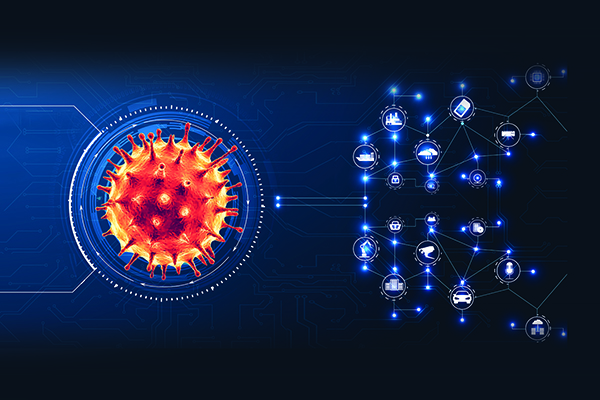
In general, this crisis made the adoption of Industry 4.0 necessary in mostly all the areas. It has helped companies to survive, recover themselves and project a new way of optimization. Covid-19 has come with new needs that havent been exploited or thought about previously. Now, businesses need to think about how to increase the safety at work, how to control covid cases and even measure people’s temperature in order to ensure cero infections. Moreover, propagation of the virus was a big concern, this made necessary a structural change in order to reduce the human contact and control and track contagious areas.
COMPETENCIES NEEDED FOR INDUSTRY 4.0
At this point, the huge power that this industry is putting into society, has been outlined several times. It is an area full of advances that in the end can only bring successful outcomes to society and the whole business world. However it is important to have in mind that not everything is easy and beautiful as it seems.
Let’s recap what Industry 4.0 focuses on. As it was mentioned in the first section of the blog post, this industry directly affects the manufacturing sector, which implies the fact that workers belonging to this area must face a series of obstacles. Right now there is a need to cover specific skills which are highly lacked in the manufacturing area which require specialty in developing and managing high tech systems. This definitely implies that Industry 4.0 is radically altering the prerequisites needed in the labor market. As every day goes by, there is an increase in the need to fulfill positions with skills that fit into this new environment. In the following paragraphs a detailed explanation of the competences required in trained professionals will be developed.
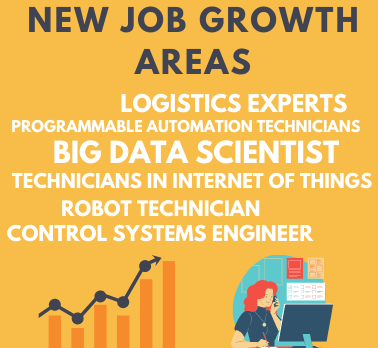
Although there is a high number of vacancies in this workplace area, there is a lack in the number of trained professionals to fulfill the specific competences that the Industry 4.0 implies. Before we delve into the specific workplaces that arise from this new area, lets outline some of the competences based on the ABET accreditation that are required in order to be successful professionals. In the first place, applying knowledge of subjects like mathematics, science and engineering are very important, as it has to do with the high technological interaction. Secondly, the ability to interact with large sets of data, be able to analyze them, and interact with them competently. Then, being able to design and develop sets of experiments, in order to recreate reality into engineering models. Finally, having the ability to create systems and processes considering the whole context in which the world is at right now, as well as understanding the impact of engineering solutions in this environment.
In addition, the importance of soft skills must also be considered. Nowadays decision making processes, problem solving, the ability to face changes in the organizational world as well as dealing efficiently with intercultural aspects, are very relevant competences which are required in the workforce. As the industry 4.0 is merged in manufacturing companies, these competences are definitely included in the daily management processes of organizations.
Furthermore, the competences required in the manufacturing industry have drastically changed. Industry 4.0, requires competences oriented to more creativity, strategic thinking and coordination skills instead of carrying out established constant and repetitive processes like the manufacturing industry did before this revolution arose.
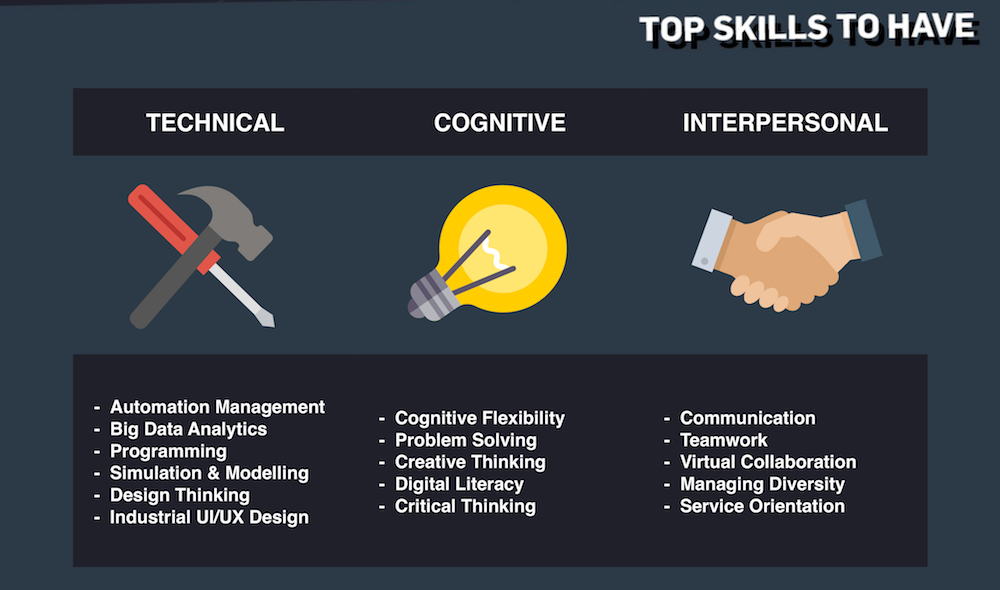
Thereupon, the main issue of this section turns up. Only a tiny percentage of society is being trained to fulfill high qualified positions, whilst analysts are predicting a radical increase in vacancies over the next couple of years. Therefore the main objective at this point is to focus on the performance of universities, which are the agents that must initiate great and effective educational programs, to train students to become successful professionals in the field of this industry. Universities must establish means of communication with the agents belonging to the professional context, including governments and expert managers from this area among others, in order to keep their courses updated and in line with what the environment is bringing up. In the case of Industry 4.0, rather than preparing professionals in many areas of increasing knowledge with huge sets of dense content; the importance of teamwork from members of different capacities is crucial. Thus, it is essential to train people to communicate and deal with others which don’t belong to their expertise zone.
Consequently, many of the most important universities worldwide are taking this into account and making changes in their degree offerings according to what the workforce is requiring in these areas. Some of the most famous examples of these procedures will be outlined in the following lines. In first place, the Massachusetts Institute of Technology, is currently offering three different programs whose aim is to develop skills to face challenges in relation to the Industry 4.0. “Markerlodge ”, is an example of these, which has the final goal to train experts to face problem solving challenges related to the innovative area of companies. This university also offers other two college programs in which the focus is placed at leadership competencies, strategic initiatives, problem solving, as well as focusing on learning how to implement industry 4.0 from an organizational point of view.
Other well-known universities around the world, also have the aim to include research approaches related to manufacturing in the high tech industry, as well as application of technical and theoretical projects into real life approaches and projects. Moreover, other undergraduate and postgraduate programs offer the possibility to be trained in making technical systems work autonomously, as well as being able to analyze large sets of data in order to automate the processes and draw conclusions from it in an accurate and efficient manner, reducing time backlogs and increasing the selection of right alternatives.Finally, having presented the fact that the educational universities systems are updating their programs to train people, to attain certain requirements so they can fit into the Industry 4.0 workplaces, we can now move on to what jobs will be offered in relation to this area. Even though there is a list including several possible job places, the most common ones will be outlined. Experts in robots coordination, including programmable automation technicians, as well as industrial robotics technicians, are essential for the main procedural functions fulfillment. Secondly, the presence of industrial data scientists, as well as big data technicians which are able to deal with large amounts of data and have the ability to interact with them efficiently. Then, a very important agent is the supply chain coordinators, which understand the logistics of a company and know where to attack and make the best out of it by reducing time backlogs and improving efficiency. Lastly, the position of control system engineers as well as digitally assisted engineers will be crucial for the functioning of Industry 4.0 as a whole.
TECHNOLOGIES OF INDUSTRY 4.0
There is still a bit of confusion about industry 4.0; it is something that is constantly changing and that will continue doing so. It includes three main trends which are connectivity, intelligence, and flexible automation, it puts together information technology and operational technology and this is possible thanks to advanced technologies. Some of the main technologies of industry 4.0 are:
Big data & Analytics
Big data refers, as it names shows, to a huge quantity of data that humans would spend an incredible amount of time trying to analyse all of it and they would still have difficulties to obtain a real value, but machines do not have that problem, they can scan all the data and give us feedback on which is the best way of optimizing the different processes, not only that, we have to take into account that the number of data that exist corresponds to all that has been collected through different web, cloud enterprises applications and others but a big part of what is collected is not used, it is important to convert the information in smart data and take only what is important for whoever wants to get something out of it and this can be done thanks to data analysis, this helps companies to be more efficient and to optimise their processes.
Industrial IoT
One of the main technologies of industry 4.0 is Industrial IoT, it is the interconnection of small sensors or other physical devices that collect data which can be real-time data and exchange it through the internet. It provides a lot of different advantages, for example it can be used to prevent running out of stock or having too much stock in some kind of business which helps them to reduce costs.
Cloud computing
The cloud is something that over the past years has started to be used a lot, it is an abstract term that refers to a software that is stored in remote servers, it is not kept in the storage of a computer, it helps as in some companies for example, or some people have to work with a lot of data and with cloud computing they do not need to have a very powerful infrastructure as they can access that data from the internet at any time
Advanced robotics
In manufacturing robotics have been used since a lot of years ago, but they have evolved and become better with industry 4.0. And a new generation of this technological branch is appearing which can do tasks that are delicate and difficult, they can learn from humans and recognise and analyse the information they receive. These robots are intelligent and can perform their tasks without the need of a human controlling them as they learn quickly from repetitive tasks.
Those are some of the main examples of Industry 4.0 technologies but there is much more such as additive manufacturing, augmented reality, digital twins, cybersecurity, artificial intelligence, 3D printing, 5Gcommunication… Thanks to all these technologies Industry 4.0 can be developed. Some of these technologies existed some years ago but it is now when they are evolving, constantly changing and being of use for society.
INDUSTRY 4.0 IN COMPANIES
New technologies have changed drastically the way entities worked, industry 4.0 in a way refers to the digital transformation of industrial companies. Nowadays using software to run a company is almost essential, it increases productivity, and the use of machines is more and more common every day. It was a smooth process as technology has been implemented on companies little by little with a small perception of it, but it is still important for them to invest in this transformation to not fall behind their competitors. It is essential to implement the technology in all the different sectors of a company for it to be more efficient and be able to obtain an integrated system in which everything is connected. It is also important for corporations to know where to implement the technology and what technology to implement, not all technologies will work the same way in each company.
Here there are some examples of the leading companies in Industry 4.0:
First of all, we have some car companies. The car industry is one of the industries that have spent more money in evolving to industry 4.0, they have applied a lot of different technologies and they continue evolving. Some examples of car companies that lead industry 4.0 are Ford with its “carsharing”, BMV by integrating their clients’ information in their productive process with an online platform, Rolls-Royce which analyses the functionality of their engines, so people have less costs or SEAT which was recognised as the European leader in digital transformation by implementing virtual reality, artificial intelligence, or big data, they are also working on a biomechanical lab among other changes.
Another leading company is Lego, which is a well known company that creates plastic pieces to build different structures. This company is going to offer the possibility of selling digital archives instead of the physical pieces so people can print them with the apparition of 3D printers.
Among others we also have General Electric, which works in important sectors such as energy, healthcare, and transport, which have software integrated machines such as Predix which is a platform that makes the analysis of all their data easier. And also, they have created Digital Windfarm which thanks to different sensors they could create personalised turbines to get a higher efficiency.
These are just some examples but there are a lot more companies that are evolving and adopting different technological changes as it is the future.
FUTURE PRODUCTS
Industry 4.0 is marked by the great technological advances that are currently being made, but also for those for which there are already plans for the future. Several new technologies are planned for the next decade, some of which will change the way we live. Many of the technologies we are going to present have already advanced over the last few years, but it will not be until the next decade that they will see exponential growth in their application.
- Prostheses connected to the brain
This will be achieved using artificial intelligence algorithms. People who wear these prostheses will feel the same as if they had a biological hand. They work with much more presumption than conventional prostheses and are attached to the bone and controlled by electrodes implanted in nerves and muscles. Companies like Open Bionics are already investing in this kind of technological breakthrough.
3. 3D printing of organic material
A lot of progress has already been made in this field and it is getting closer to being able to manufacture a functional heart or liver via a 3D printer, but the automatization of such processes is still something that remains in the hands of the future.
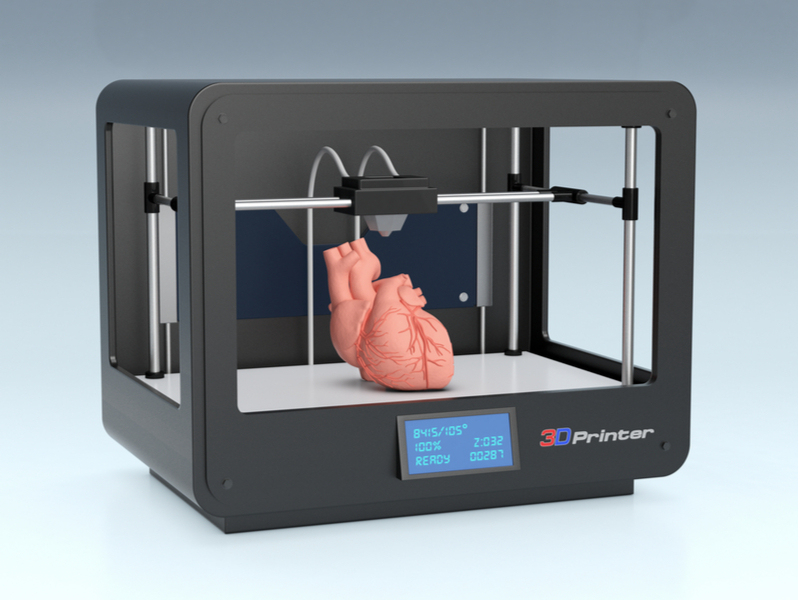
2. Smart fabrics
This is a technological revolution in the textile world where clothing will be able to control even our Smartphone. This would happen thanks to the development of smart tissues. They are manufactured to integrate technologies that offer the user added value and greater functionality. It is expected that through it you can regulate the temperature or send information about your physical condition at the time of wearing it. Smart fabrics allow users to interact with their environment and communicate data. An example of a company that is already using these smart fabrics would be CuteCircuit, which has brought out a t-shirt that allows deaf people to experience music through their bodies with the help of a smart garment.
4. Technological evolution in the automotive industry
As we have already mentioned in current examples, the automotive industry is one of the leaders in technological advances applying the internet of things.It is expected that automatic cars will prevail in the future and that even flying cars will appear. A good example of a company that will be part of the revolution in this sector will be Tesla, one of the leaders in the application of new technologies in their vehicles.
AUTHORS
Maria Garcia Lazaro:

I am a Business and Technology student, willing to constantly learn and share my knowledge on these fields. I am a big fan of the impact that technologies are having in the organizational environment worldwide. Always focused on achieving the best results possible, having in mind that hard work, effort and consistency are the key to success. I love enjoying quality time with my family and friends, and I consider myself enthusiast about travelling around the world and discovering different cultures!
Irene Corrales Alonso:

My desire for being prepared for this new technological era has made me enroll in the Management and Technology career a few years ago. Also, as I started learning about new things that I didn´t exploit earlier, I became fascinated by the world of Finance, making me enrol as well in the course of Finance and Accounting at Carlos III University. I really enjoy trying new types of dishes, challenging myself and spending time with people I do love and care about. My future wish is to end up working in something that fascinates me and completes me at same time.
Marina Laguens García:

I am a student of Management and Technology at Carlos III University as I have always been interested in business and new emerging technologies that could be applied to it. For that reason, I decided to complement my main career with studies of Informatics Engineering in order to learn more deeply about this field. My goal is to grow constantly on both personal and professional sides and take every opportunity to learn from the people around me. I am passionate about travelling and meeting new people and cultures that could enrich my knowledge and open my mind. Spending time with my family and the people that I love is also essential for me. In the future, I would like to give my best as a professional, being perseverant, applying everything learnt and continuing growing from every new challenge.
Almudena Izquierdo Barbadillo

I am currently starting my career of Business Administration at Carlos III University. My interest in business and how this industry works made me pursue this degree, and concerned about the important role that technology plays in this field nowadays, I started a minor at Management and Technology, which I am enjoying very much. I consider myself a very charismatic and curious person and with a constant desire to learn new things. I love being surrounded by the people I love and exploring new places. In the future I see myself working in the business world, hopefully in a fashion firm, and contributing to the improvement of society.
Adriana Escuder Romero:

If I have something clear in life, it is that your excuses define your future. I am a young student with a great desire to continue cultivating myself and fill myself with knowledge and experiences to continue growing and be proud of my passage through life. My ambition for digital transformation and the business world made me choose the degree of Management and technology at Carlos III University of Madrid. I am currently in my second year and the third year I will do it at Queen’s Business University (Canadá).
María del Prado Burgaz Zaballa

I am a Management and technology student, I like changes and facing new challenges, because of that I quite like the technology field as it is constantly evolving, and I want to always be informed on what is new. I have a lot of perseverance and I try to achieve everything that I propose. I like working with other people as it helps me see other perspectives that I cannot see by myself. I am passionate about travelling, I see it as a way of learning new things, new cultures and getting to know a lot of new people. I love spending time with my family and friends and being outside in nature and I also love animals. In the future I see myself working in something that I enjoy.
Carlota Pérez Prieto

I am a management and technology student at the Carlos III University in Madrid. Although at first I had a hard time identifying how I wanted to define my future and what to study, now I’m clear that I made the best decision. I believe that this race is paving the way for a future that will be shaped by technology. I have always considered myself an ambitious person, that when I have a clear goal, I do everything in my power to achieve it. Traveling and filling myself with new experiences are two of my favorite activities. I love being outdoors and being able to enjoy the company of my friends and family, I am also a very active and sporty person.
BIBLIOGRAPHY
¿Qué es la Industria 4.0? (2018, 25 enero). Deloitte Spain. https://www2.deloitte.com/es/es/pages/manufacturing/articles/que-es-la-industria-4.0.html
Marr, B. (2019, 11 julio). What is Industry 4.0? Here’s A Super Easy Explanation For Anyone. Forbes. https://www.forbes.com/sites/bernardmarr/2018/09/02/what-is-industry-4-0-heres-a-super-easy-explanation-for-anyone/
i-SCOOP. (2021b, febrero 17). Industry 4.0: fourth industrial revolution guide to Industrie 4.0. https://www.i-scoop.eu/industry-4-0/#industry-40-definitions-what-is-industry-40
Arrieta, E. (2017, 11 agosto). Diez empresas que lideran la Industria 4.0. ExpansiÃ3n.com. https://www.expansion.com/economia-digital/innovacion/2017/11/08/59f8a85922601d1b458b4618.html
Y. (2020, 29 julio). 5 Ejemplos de empresas que lideran la industria 4.0. Yeeply. https://www.yeeply.com/blog/ejemplos-empresas-industria-4-0/
Immerman, G. (2021, 25 febrero). Emerging Industry 4.0 Technologies With Real-World Examples. MachineMetrics. https://www.machinemetrics.com/blog/industry-4-0-technologies
A. (2020a, diciembre 18). Industry 4.0: 7 Real-World Examples of Digital Manufacturing in Action. AMFG. https://amfg.ai/2019/03/28/industry-4-0-7-real-world-examples-of-digital-manufacturing-in-action/
A. (2020c, diciembre 18). Industry 4.0: 7 Real-World Examples of Digital Manufacturing in Action. AMFG. https://amfg.ai/2019/03/28/industry-4-0-7-real-world-examples-of-digital-manufacturing-in-action/
Hernandez-De-Menendez, M. (2020, 2 noviembre). Competencies for Industry 4.0. International Journal on Interactive Design and Manufacturing (IJIDeM). https://link.springer.com/article/10.1007/s12008-020-00716-2?error=cookies_not_supported&code=6a3a20c9-e198-45c4-8f68-b79283fe5aba
Ekanayaka, S. (2020b, julio 14). COVID-19 vs Industry 4.0. MyScienceWork. https://www.mysciencework.com/omniscience/covid-19-vs-industry-4-0
Belén, V. S. (2020, 22 junio). Cuarta Revolución Industrial. Economipedia. https://economipedia.com/definiciones/cuarta-revolucion-industrial.html
S. (2020d, febrero 17). La Industria 4.0 y sus orígenes. Aspromec. https://aspromec.org/la-industria-4-0-y-sus-origenes/
Ramos, C. L. (2020, 5 septiembre). 5 tecnologías que en 2030 ya serán una realidad. ComputerHoy. https://computerhoy.com/listas/tecnologia/5-tecnologias-2030-ya-seran-realidad-702823Agrawal, M., Dutta, S., Kelly, R., & Millán, I. (2021, 20 enero). COVID-19: An inflection point for Industry 4.0. McKinsey & Company. https://www.mckinsey.com/business-functions/operations/our-insights/covid-19-an-inflection-point-for-industry-40#
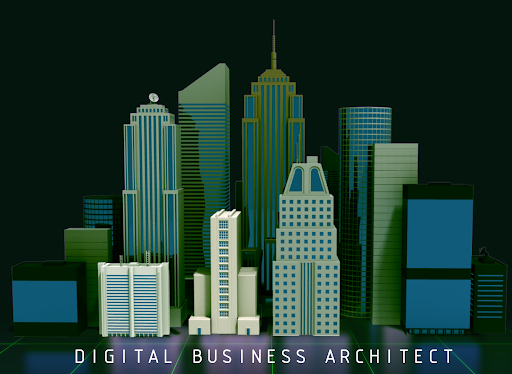
3D printing, analytics, automation, Big Data, cloud computing, connection, Digital Technologies, Industry4.0, IoT, nanotechnology, robotics, simulation, system integration
